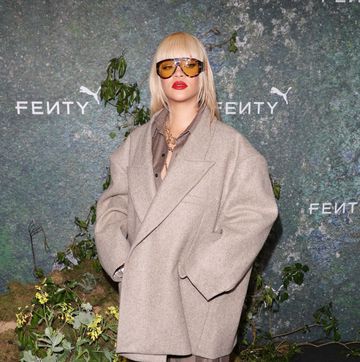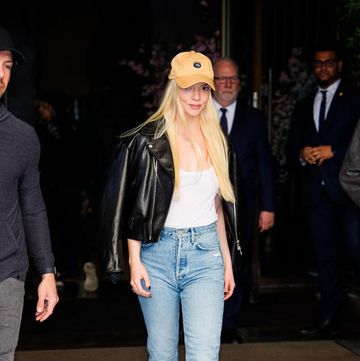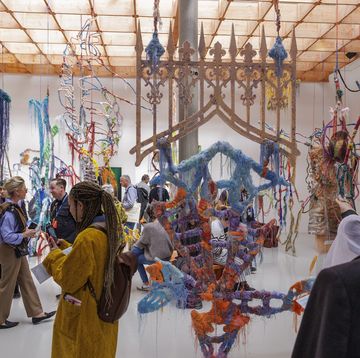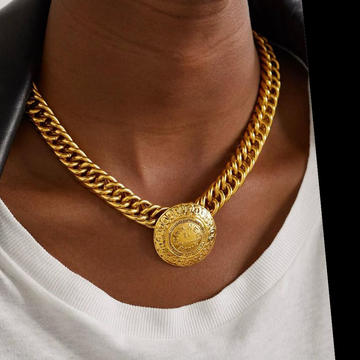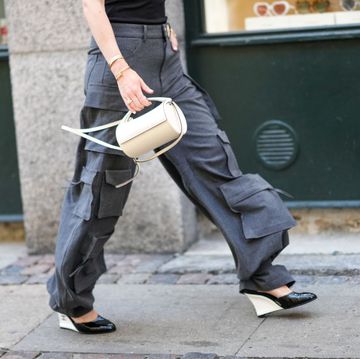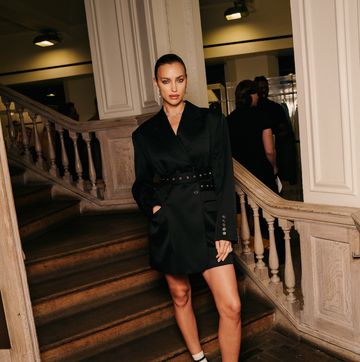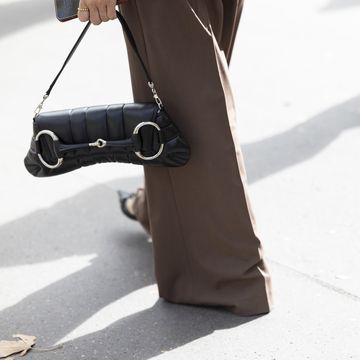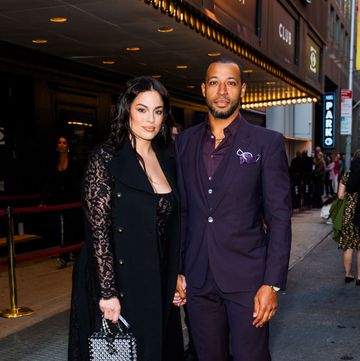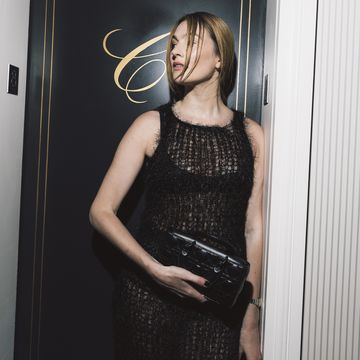As Iris Apfel appears in the Kate Spade New York s/s 2015 ad campaign, we take a look back to our December 2011 issue, where Rebecca Lowthorpe talked to her about style, passion and her designs for yoox.com.
Iris Apfel is 90 years old, but I suspect this means more to everybody else than it does to her. I must confess something before we begin. I had assumed this self-proclaimed ‘geriatric starlet’, who has in the past five years become a giant in fashion – a maverick icon with four museum shows chronicling her idiosyncratic style; a book, Rare Bird of Fashion: the Irreverent Iris Apfel, under her couture belt, and, according to New York Magazine, the only person teenage blog-queen Tavi would like to go shopping with – to be a rich New York dowager type. An almost-unique Park Avenue Princess – albeit one who dares to be different – who had probably never worked a day in her life, being, I supposed, in possession of her husband’s fortune, with which she had amassed a staggering amount of beautiful, price-no-object clothes. Not to mention an eccentric nut, a bit dotty perhaps, not altogether there.
This couldn’t be further from the truth. Iris Apfel is the very definition of modern. She has never stopped working, having made her mark on the world long before many of us were born. She built, with her husband Carl, a textile business that was so prestigious it was enlisted for its services by nine administrations of The White House. Today, to her surprise, she is busier than ever, with her jewellery line for yoox.com launching this month, a cosmetics and eyewear line in the offing and a collection for the Home Shopping Network (‘I’ll be peddling this next week,’ she says later, holding up a £65 black-fleece bowling-ball bag with red trim). She is also filming a documentary, of which she is the subject, directed by Albert Maysles, ‘the godfather of documentaries’ as she puts it. Then there’s her work with the University of Texas, which has made her a visiting faculty fellow (‘So, treat me with respect, girl,’ she hoots). And when she’s not busy with all that, she’s doing interviews and photo shoots. With her personal assistant she fields around 40 phone calls a day.
So, no, Iris Apfel isn’t dotty. Whether she’s ‘made of squllions’ – she claims not – is hard to ascertain. But she is absolutely here, in the room with me, formidably present.
She greets me with a fragile hand in her Park Avenue apartment. It’s not moneyed, not grand, more Ye Old Curiosity Shoppe, every surface covered with a lifetime of knick-knacks, books, teddy bears perched on chairs, the odd-gilt framed masterpiece. (She catches me marvelling at a painting in the hall that might be a Velázquez. She’s too scared to find out because that would mean she would no longer be able to enjoy looking at the girl in the painting with the pink ribbons in her hair, which is why she bought it in the first place.)
She likes everything with a quirk, a personality. Like the carved wooden dog that greets you as you enter the living room, sporting red-rimmed shades, or the kitchen clock – essentially a plate with a life-like tomato sandwich on it.
Apfel is wearing her trademark gigantic black-rimmed glasses, leggings and a man-sized denim Western shirt adorned with patches – Mickey Mouse wields a lasso on one shoulder, Minnie Mouse totes a pistol on the other. She likes to be ‘casual’ at home.
‘People have this incorrect concept.’ She says incredulously – her voice a deep drawl straight out of a black and white movie – meaning they expect to see her ‘all gussied-up’ or shopping in only the grandest of New York’s designer emporia. She prefers discount stores ‘because I don’t have any sales person telling me, “Oh, you have to have this, dorrling. Every chic woman in New York is wearing it.” Then, of course, I don’t want it.’ It’s the digging around, the hunt for ‘the treasures and oddball things’ that she enjoys. ‘I like to look at something and conjure up an outfit. I love to put things together. It’s very, very calmful for me.’ This could mean throwing a flea-market coat on with a Qing Dynasty chest ornament, or teaming £10 jeans and furry moon boots with a more precious archive, a Christian Dior haute-couture evening coat, say, or a Native American dancing skirt. ‘It’s not how much it is, it’s what it is,’ she likes to say. So, is shopping her therapy? ‘Well, I don’t do much shopping any more – I have so much stuff. But when I feel I’m going loony, I tell my husband, “it really is cheaper than going to a psychiatrist”.’
Last night, she was playing stylist to four Loehmann’s shoppers. The store, specialising in basics and end-of-season designer stock, was, like Apfel, celebrating its 90th year and had invited her to host the event. One woman, she says, whose ambition was to look like Grace Kelly with an edge, wasn’t easy at all. ‘She said she wanted to learn, but she was very set. I had to beat her with a stick even to try things on.’ Apfel transformed her by way of a heavily beaded Valentino dress and a three-colour fur stole. But it was the woman ‘who said her butt was so big it was in another zip code’ that she particularly enjoyed. ‘She was very plump. But she was so full of spirit and light with absolutely no complex about the way she looked.’ Apfel put her in a red printed Gaultier dress, fringed shawl and black bangles. ‘I was so pleased with myself, because I made her look great.’
Apfel thinks it was madness when women tell her how inspirational she is, how she’s changed their lives. ‘What sorry little life did they have before I came along?’ she’ll say. But, equally, it seems helping women find their inner confidence and thus their own style has become a mission.
‘You have no idea how crippling this thing is to women’s psyches. I don’t think fashion is as flip as lots of people make it out be,’ she says. ‘It’s a very serious matter. It reflects what’s going on in the world, the economy, sociology and the psychology of a certain period. The way you dress shows who you are and who you want to be.’
And who does she want to be? ‘Me! I’m very happy in my own skin. I do what I feel. I operate at a gut level.’
An hour later, we’re off to her friend Ralph Rucci’s show. It’s New York Fashion Week and Apfel is dresses in an egg-yolk-yellow coat by Rucci, her arms encased in plastic ‘googly eye’ bangles – literally, the kind of plastic ‘eyes’ you find in a child’s craft-making kit. She carries a black and white fur Marni bag and a walking cane but, fearful of tripping, she grips my arm like a vice.
‘Wow, you ain’t lost an ounce of that, kid. The dazzle!’ cries a delighted Bill Cunningham, the legendary spry octogenarian New York Times street-style photographer, looking through his lens. Next to him, teenagers are snapping her with their mobile phones. ‘Who is she?’ asks one. ‘I dunno, but I’m loving her,’ replies her friend.
Inside, she poses with the striking white-haired model Carmen Dell’Orefice (‘Takes a lot of security to be in a picture with this one,’ says Apfel) before a throng of well-wishers, acquaintances and people who she has ‘absolutely no idea how they are’ cone to air kiss and pay homage, or stick a TV camera in her face. ‘Psst,’ she whispers, now in her seat, ‘look at that!’ She feigns horror at a big woman in frills, which prompts another Apfel axiom. ‘You know what I tell people who ask me what’s a fashion faux pas? It’s when you look in the mirror and see a stranger staring back.’
Iris Apfel, née Barrel, as born in August 1921 to a Jewish family in Queens. But it’s her Russian immigrant grandparents, who came to New York by boat from the province of Minsk, that seem to underpin her whole entity. Her grandfather was a master tailor (‘a genius with buttonholes’), her stoic grandmother ‘a cleanliness freak, who used up all the housewifey genes’. Her father, in the glass and mirror business, wore clothes well, but it was her mother who had great style. ‘Not froufrou pretty, but pretty. She was always impeccable, like the Duchess of Windsor.’ Her mother had trained as a lawyer, but inherited a boutique after a business meal went sour. She loved to dress her daughter up. Apfel remembers, aged-four, objecting to the colour of ribbon her mother had tied in her hair. ‘I kept screaming, “It doesn’t match, it doesn’t match.” Now, I hate anything matchy-matchy,’ she says. Was she a rebel dresser in her teens? ‘Well, the hot thing was saddle shoes,’ she says, referring to the 1930s white golf-style brogues. ‘The idea was to get them as dirty as possible and have people autograph all over them, like graffiti.’ She was devastated when her grandmother cleaned them up.
Her sartorial rebellions punctuate the important moments in her life. After studying fine art at New York University and Wisconsin, she was pushed by her security-conscious family into a teacher-training programme. To liven things up, she wrote a paper on jazz and ended up befriending Duke Ellington (‘Lordy, lordy, who’s your tailor?’ asked his band leader when he saw Apfel at the stage door, in an old beau’s cream Cornell University blazer).
She says she was probably the first woman in America to wear jeans, the ideal accompaniment she felt to a big turban and hoop earrings. The Army & Navy store refused to sell them to her. ‘They said, “Don’t you know that young ladies don’t wear jeans?” I said, “I didn’t come here for that information,” and they threw me out.’ But her persistence paid off and on her third attempt they sold her a pair of boys’ jeans.
The first time she met Carl Apfel was on holiday in Lake George in August 1947. He told a mutual friend that she’d be very attractive if she’d only get her nose fixed. Apfel said, ‘Well, you can tell him what to do.’ A month later, he spotted her striding down Fifth Avenue wearing a man’s tailored suit, flat brown shoes and an interesting hat. He pursued; they married six months later. Then came the high old days, travelling the globe, working for their interiors business through Europe, Africa, the Middle East, parts of Asia. ‘I never saw more style in my life than in Naples right after World War II. They were literally walking around in rags, but they had such flair,’ she remembers.
It was in Paris, though, that she had the good sense to buy couture runway samples for a song, once she’d got to know which fashion houses used mannequins her size. She amassed an enormous collection of Lanvin, Dior, Balenciaga, Nina Ricci, Jean-Louis Scherrer – now all part of her museum collection. She could still wear them, however. She is very thin. At 5ft 6in, she weighs a mere 7 ½ stone. ‘My waistline has stayed the same – it’s the closet that’s swollen,’ she says.
Back at her apartment, she’s eager to show me her latest venture. She is very pleased with her jewellery for yoox.com, particularly the rhinestone frog brooch. There are three elements to the collection: a bold, moderately priced ‘more organic than bling’ range; a limited-edition range comprising one-of-a-kind ‘drop-dead bracelets and some really wild earrings’ and 50 pieces form her own collection that she describes as ‘haute-couture pieces and garbage, but I like the and that’s what counts.’
As she pulls out a hand-painted Oscar de la Renta coat for me to admire, we discuss, among other things, her politics – she’s ‘socially liberal but fiscally responsible’. Her faith – ‘I don’t go to temple but I believe in God’. Choosing not to have children – ‘Because I know that when I was left with my grandmother while my mother was working, I resented it terribly’. And why people might think she is fabulous – ‘Maybe because I’m different and I say what I think? Maybe because I’m so old?’
The day after I interviewed Apfel, she fell in her apartment and broke her hip. Knowing how fragile she is now makes writing this all the more poignant. When I asked her, ‘How is it that, at the age of 90, you’re so game? So in the game?’ She replied, with typical wit, ‘I mean, I’m still here. There’s no sense sitting on the sidelines if I don’t have to. I have always been into everything. I have a tremendous curiosity an, as long as I can stand up and move around, why not, if people ask me? I think it beats going to pasture… and mooing.’
Iris Apfel, American businesswoman, interior designer, fashion icon. It doesn’t get more inspirational than that.
Image: Getty

